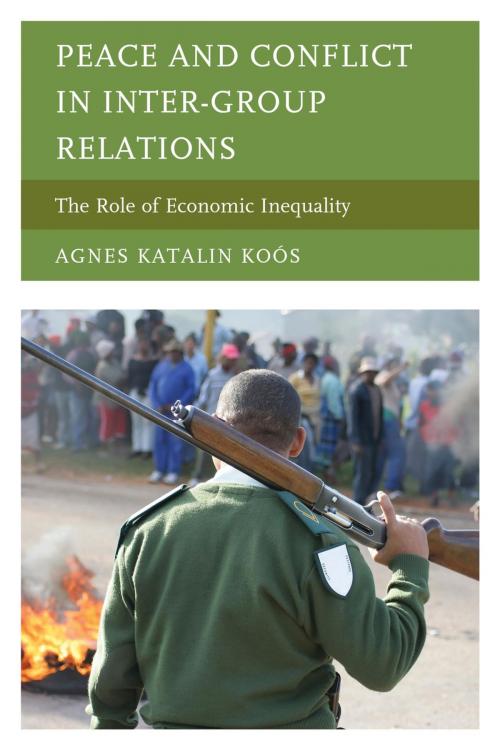Peace and Conflict in Inter-Group Relations
The Role of Economic Inequality
Nonfiction, Social & Cultural Studies, Political Science, International, Foreign Legal Systems, International Relations| Author: | Agnes Katalin Koós | ISBN: | 9781498502894 |
| Publisher: | Lexington Books | Publication: | November 18, 2014 |
| Imprint: | Lexington Books | Language: | English |
| Author: | Agnes Katalin Koós |
| ISBN: | 9781498502894 |
| Publisher: | Lexington Books |
| Publication: | November 18, 2014 |
| Imprint: | Lexington Books |
| Language: | English |
The book ventures into the explanation of intra-state communal conflict, more narrowly of the conflict between majority and minority communal groups, and develops arguments that highlight the causal impact of intergroup economic inequality. Its quest for empirical support has led to the compilation of three large, inter-related datasets, typifying the condition of minorities worldwide. They are mainly based on the Ethnic Power Relations, Minorities at Risk, and Quality of Government data, yet also involve information from a multitude of other sources, such as national statistics, cross-national demographic surveys, and the World Directory of Minorities and Indigenous Peoples.
The group-level data, featuring 860 communal groups, show that an impressive forty-five percent of the world’s population do not belong to the majority communal group in their country. As reasonably feared, minorities are in general politically less empowered than their pluralities, and also poorer. Results from multivariate regression analysis corroborate the deleterious impact of horizontal economic inequality on inter-group hostility, measured either as group grievance or violent conflict. The double measurement substantiates the intuition that not all low-to-medium strength hostility is doomed to develop into violent conflict. In fortunate conditions, intergroup disputes can be solved, or compromises may be reached without turning to violence. Part of the analytical efforts have been directed towards detecting the differences between the causes of communal and non-communal social conflicts; and also towards deciphering which institutional conditions aggravate and which mitigate communal conflicts. A large number of variables in the regression models attempt to operationalize constellations that influence the evolution of conflicts either toward peaceful solutions or toward armed collision.
The policy implications of the findings are not trivial. Positive discrimination, which in the United States is known as Affirmative Action, is often resisted by denying the unfortunate facts that make it necessary. In addition, currently the policies recommended for heterogeneous societies are also fiercely debated between advocates of power-sharing arrangements and those who would like to facilitate the communal homogenization of each state. This latter type of constitutional engineering is at variance with the political empowerment of minorities, a measure that could alleviate tensions rooted in economic disadvantages.
The book ventures into the explanation of intra-state communal conflict, more narrowly of the conflict between majority and minority communal groups, and develops arguments that highlight the causal impact of intergroup economic inequality. Its quest for empirical support has led to the compilation of three large, inter-related datasets, typifying the condition of minorities worldwide. They are mainly based on the Ethnic Power Relations, Minorities at Risk, and Quality of Government data, yet also involve information from a multitude of other sources, such as national statistics, cross-national demographic surveys, and the World Directory of Minorities and Indigenous Peoples.
The group-level data, featuring 860 communal groups, show that an impressive forty-five percent of the world’s population do not belong to the majority communal group in their country. As reasonably feared, minorities are in general politically less empowered than their pluralities, and also poorer. Results from multivariate regression analysis corroborate the deleterious impact of horizontal economic inequality on inter-group hostility, measured either as group grievance or violent conflict. The double measurement substantiates the intuition that not all low-to-medium strength hostility is doomed to develop into violent conflict. In fortunate conditions, intergroup disputes can be solved, or compromises may be reached without turning to violence. Part of the analytical efforts have been directed towards detecting the differences between the causes of communal and non-communal social conflicts; and also towards deciphering which institutional conditions aggravate and which mitigate communal conflicts. A large number of variables in the regression models attempt to operationalize constellations that influence the evolution of conflicts either toward peaceful solutions or toward armed collision.
The policy implications of the findings are not trivial. Positive discrimination, which in the United States is known as Affirmative Action, is often resisted by denying the unfortunate facts that make it necessary. In addition, currently the policies recommended for heterogeneous societies are also fiercely debated between advocates of power-sharing arrangements and those who would like to facilitate the communal homogenization of each state. This latter type of constitutional engineering is at variance with the political empowerment of minorities, a measure that could alleviate tensions rooted in economic disadvantages.















